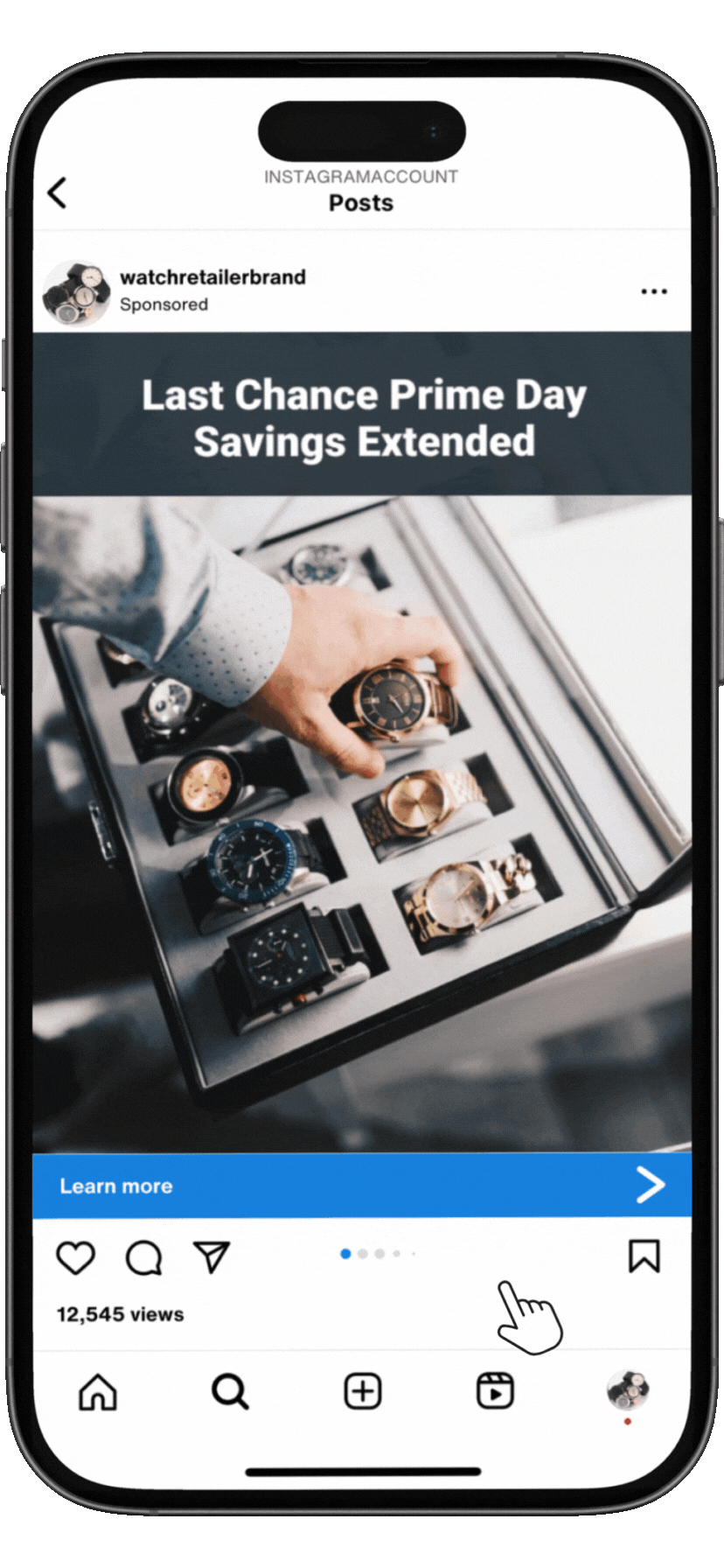Strike Overview
- A good click-through rate (CTR) is one key metric in digital advertising, and it varies greatly depending on your industry and the platform you are advertising on. The key is understanding the average CTR and knowing how your performance compares to it.
- Aside from knowing what click through rate means in social media advertising, it’s also pertinent to know the formula used to calculate it. This will allow you to quickly assess your current CTR when reviewing ad management dashboards and identify areas for improvement.
- Strike Social provides your guide to click-through rates, so read on for a deeper understanding of your social media advertising CTR.
Jump to Section
Get exclusive content on paid social media.
Join our mailing list for the latest updates.

This post was updated in July 2025 to provide you with the latest information.
Understanding Click-Through Rates in Paid Social Media Advertising
Clicks are a fundamental part of online interaction. Whether it’s someone scrolling through a social media feed, browsing the web, or navigating through apps, clicks are everywhere. Beneath the steady hum of daily life, you’ll hear the sound of people clicking away as they explore, work, and engage online.
For brands investing in paid social media, clickthroughs take on the form of engagement and knowing if your ads are influencing audiences to click and go to your website or make a purchase of your product.
To see how your campaigns are faring, you need to look deeper than just the number of total clicks your ads are getting. That’s only skimming the surface of your results. A good indicator of how you’re performing is calculating the click-through rate.
Check and calculate CTR for your campaign using the calculator below:
Impressions Click-Through Rate Calculator
Views Click-Through Rate (CTR) Calculator
What is click-through rate?
Because clickthrough rates encompass a wider concept in digital advertising, such as email marketing, display ads, and more, we’ll focus on the essence of CTR in social media advertising here.
Defining advertising CTR
Click-through rate is defined as the number of people who click through to your website from your ads. It’s the number of people who, upon viewing your ad, want to know more about what you’re offering.
This number represents the level of engagement your ads are receiving. It shows that people are responding to your ads, which is great news. However, it’s important that you consider this metric in its full context. You want to look at both the number of clicks your ads receive and the number of total views they’re earning.
For example, gaining 1,000 clicks sounds impressive, until you throw in the fact that the ad had a million impressions. That 1,000 now looks relatively small, right? As mentioned above, click-through rate is more than just looking at the number of clicks earned.
The click-through rate is the most influential component of determining your quality score, which in turn affects any future ad placement.
What affects click-through rate?
As with every other metric used to measure the success of your campaign, there are a few factors that affect the click-through rate. Here’s a brief highlight of the main ones.
Relevance
This goes for your keywords, ad copy, placements and landing pages. To achieve a good ad relevance score, the keywords and ad copy should be sending the same message, which should be targeted to the right audience. Irrelevant keywords will target the wrong audience. Therefore you’ll receive clicks from people who aren’t interested in your product or service.
Ad Rank
While your relevance could be high, sometimes ad rank is still low. Ad rank ultimately decides which ad will show in which position on a page. It’s determined by multiplying your CPC bid and your quality score. If your ad falls below the fold on screen, the odds your ad gets viewed, much less actually earns a click, diminishes. Which leads us to viewability.
Viewability
This is a metric that measures only those impressions that can be seen by an internet user. It means an ad becomes viewable when it is available in the space of your screen. Should someone have to scroll to see it, it means the ad is below the fold and has no viewability until the consumer scrolls down the page.
Each platform has a different measure of viewability when it comes to videos, however. Three seconds or more counts for Facebook, Instagram and Twitter. YouTube calls it viewable after at least 30 seconds have been watched or less, if the video is shorter.
Device
Click-through rate on mobile is actually higher than it is on desktop, due to consumers relying heavily on their mobile devices and smartphones. That’s not to say you shouldn’t place ads on desktops at all, just keep those mobile rates in mind.
Vertical
Your industry also determines click-through rate, especially when considering the competition. Remember to check the search volume for your keywords to decide how much money you’re willing to put behind them.
How do you calculate CTR?
Formula for click through rate
The formula for calculating click-through rate can vary depending on the campaign objective. Here’s how to calculate click-through rate:


Example: Consider a video game brand running a YouTube video reach campaign with a “Shop Now” call-to-action. In addition to building awareness, the goal is to drive clicks to the website for pre-orders of a newly launched gaming console, say the PS5 Pro, for example. The campaign generated 300,000 impressions in the first month and received 500 clicks.
Let’s use the Impressions CTR formula:
Impressions click through rate = [Total clicks/ Total impressions] x 100%
Impressions click through rate = [500 / 300,000] x 100%
Impressions click through rate = 0.16%
What is a good click-through rate for social media advertising?
Since not all social media ad campaigns are designed or focused on acquiring clicks from views or impressions, average click through rates can vary. So, what are the benchmarks for social media advertising CTR across different platforms?
Based on industry benchmarks and Strike Social’s Campaign Lab data, we share with you the prevailing clickthrough rates:
YouTube CTR
While YouTube is often recognized for boosting brand awareness, it has also proven highly effective at driving traffic and action. The Demand Gen campaign format, which builds on Video Action Campaigns, has achieved clickthrough rates as high as 7.6% for entertainment advertisers.
Since Demand Gen encourages users to take action, such as clicking through to a landing page, it serves as a strong benchmark for measuring engagement. These newer YouTube ad formats give us valuable insight into where the average YouTube click through rate typically falls and how to define a good YouTube click through rate based on campaign objectives.
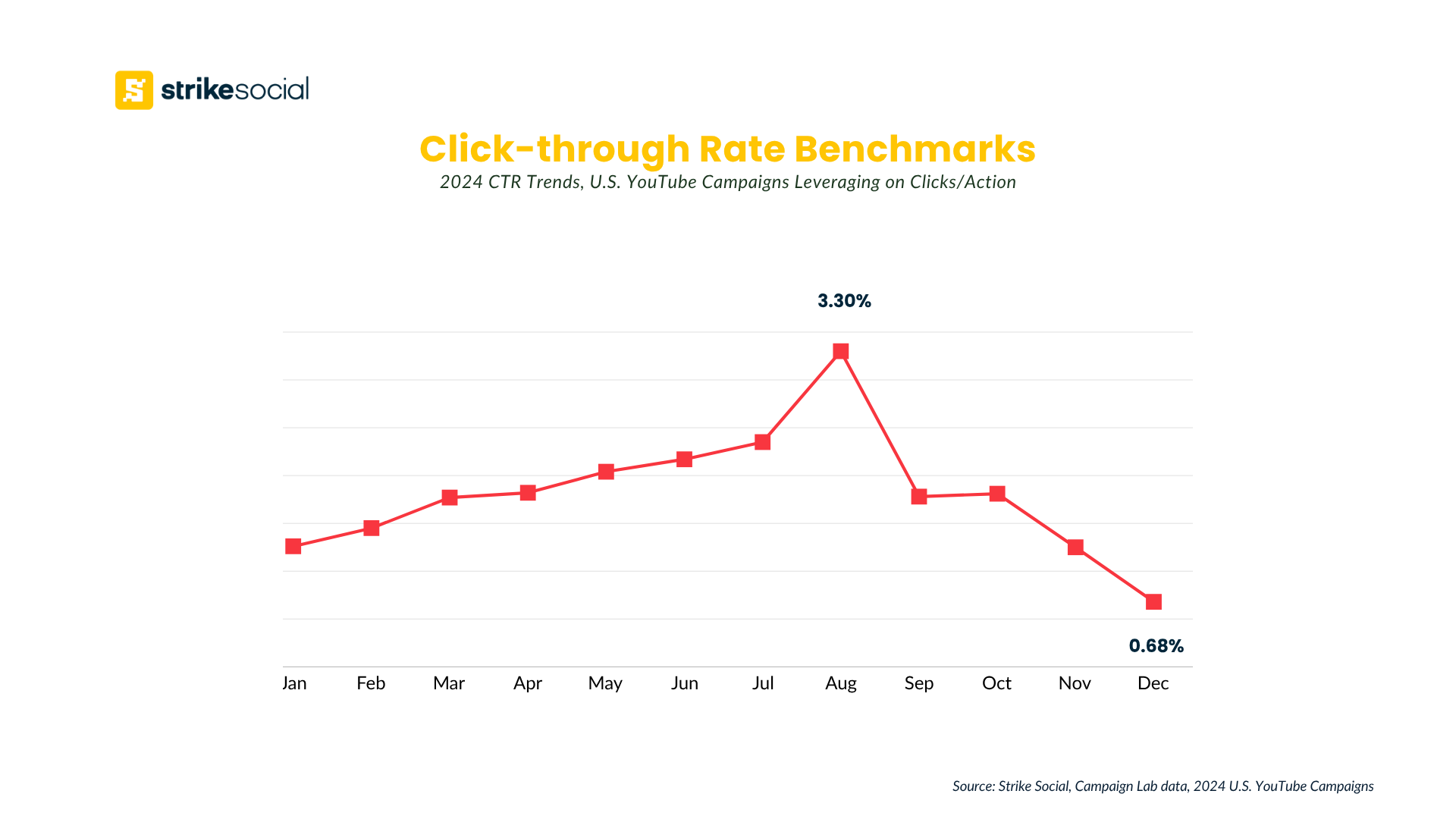
Average CTR for Facebook Ads
Facebook’s ad platform continues to prove its flexibility across campaign goals, with a click through rate on Facebook ads ranging from 1.92% to as high as 7.13%. This wide range reflects how campaign performance can scale with the right strategies in place.
As Meta’s Advantage+ tools become more widely adopted, advertisers are seeing improved cost efficiency, lower CPMs and CPCs, while still achieving strong click-through performance. While the average CTR for Facebook ads can vary depending on audience segments and creative, ongoing manual optimization remains essential in steering your campaigns toward a good CTR.
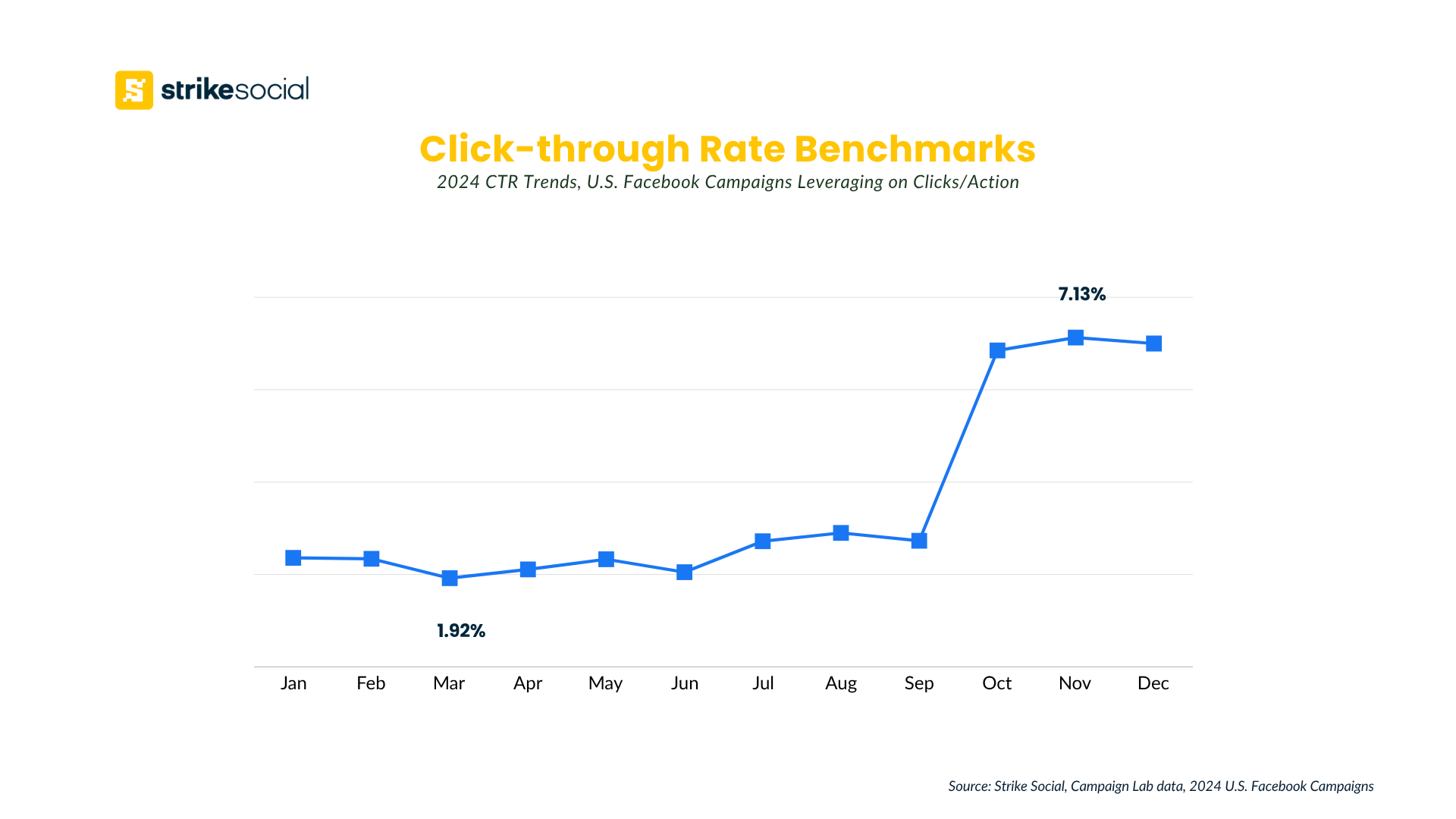
Further Reading
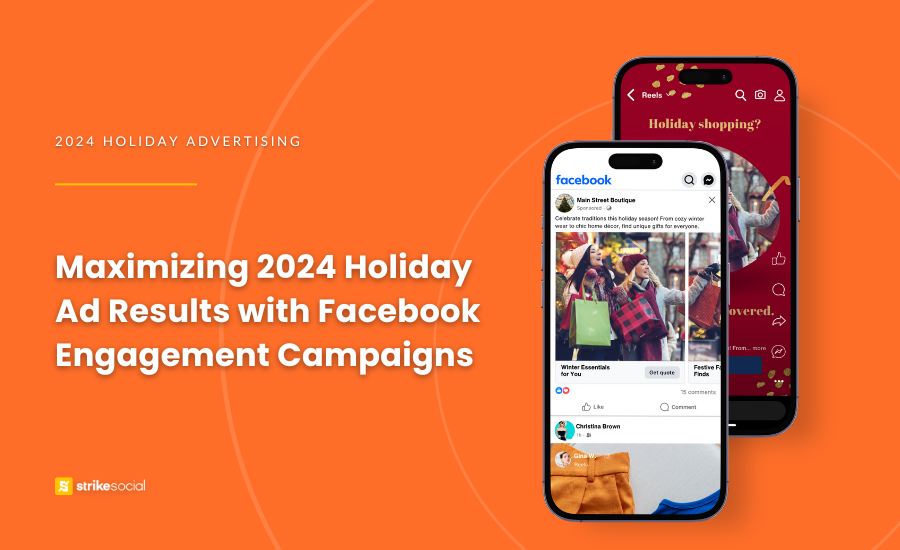
Post Engagement Campaigns for Holiday Advertising
If you’ve exhausted your impressions and views campaigns, it’s time to shift focus to lower-funnel strategies, especially post-engagement campaigns. Discover how they can drive success in your holiday advertising efforts.
Instagram Advertising CTR
The Instagram click-through rate tends to fluctuate throughout the year but can reach up to 5.30%, particularly during high-demand periods like Q4 holiday campaigns. Our click-driven campaigns consistently show strong performance in both Q4 and Q1, indicating that Instagram remains a powerful platform for bottom-funnel engagement during and after peak seasons.
We’re also seeing that Instagram CTRs often mirror or even surpass click through rates on Facebook ads in early-year campaigns, reinforcing the platform’s potential to drive action when creative and targeting strategies align.
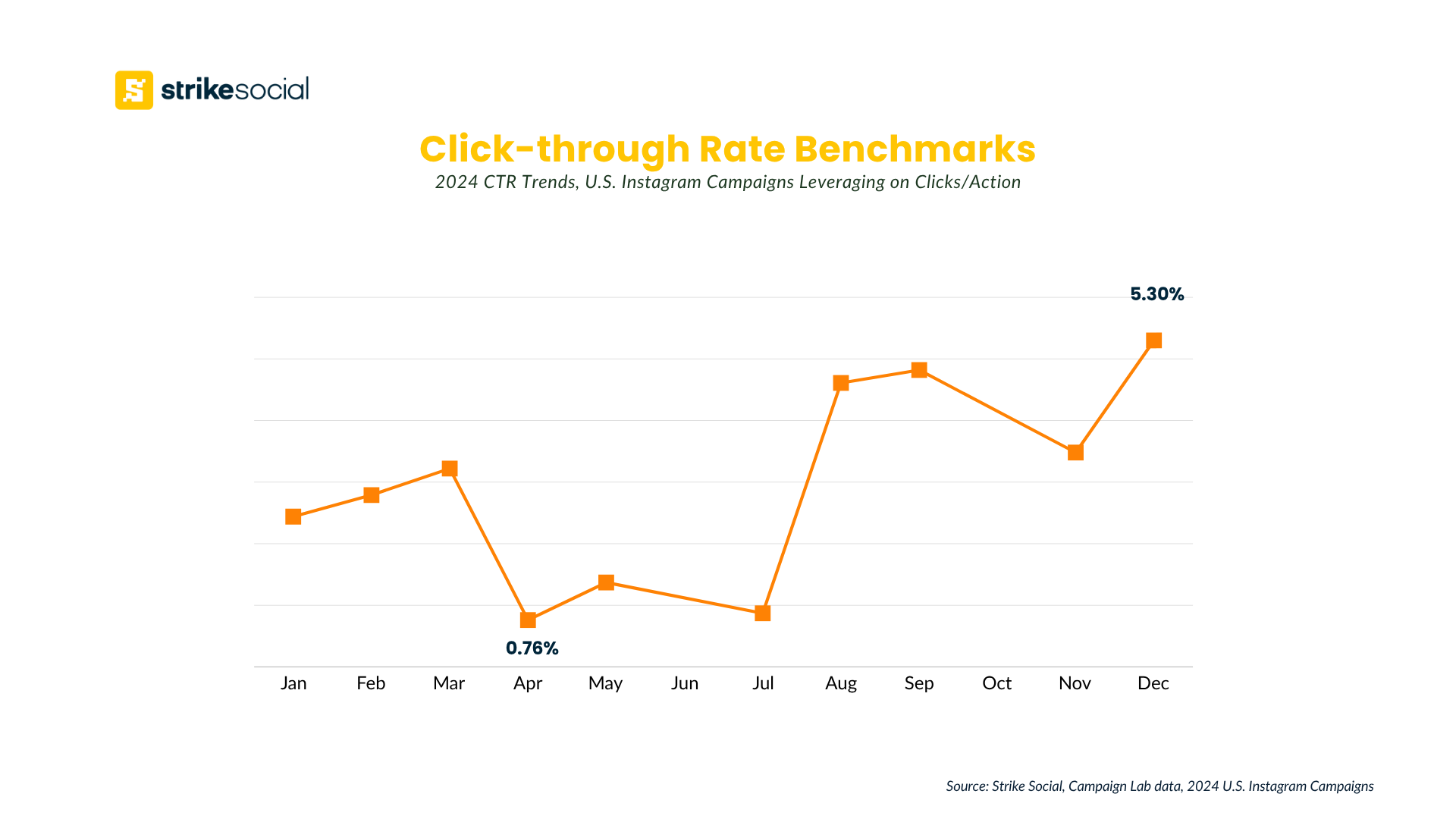
TikTok Ad Click Through Rate
TikTok continues to show strong performance across the funnel, with campaigns delivering up to 69% greater CPC efficiency for Gen Z audiences and achieving 32% lower CPMs for older demographics. These trends highlight TikTok’s growing value as a platform for both reach and action.
The average TikTok CTR ranges from 0.63% to 3.76%, closely aligning with the YouTube click through rate, a similarity that reflects both platforms’ video-first nature. To hit the higher end of this TikTok ad click through rate range, especially during peak periods like Q2 and Q4, strategies such as DMA-based targeting and fine-tuned Gen Z audience segmentation are essential for maximizing performance.
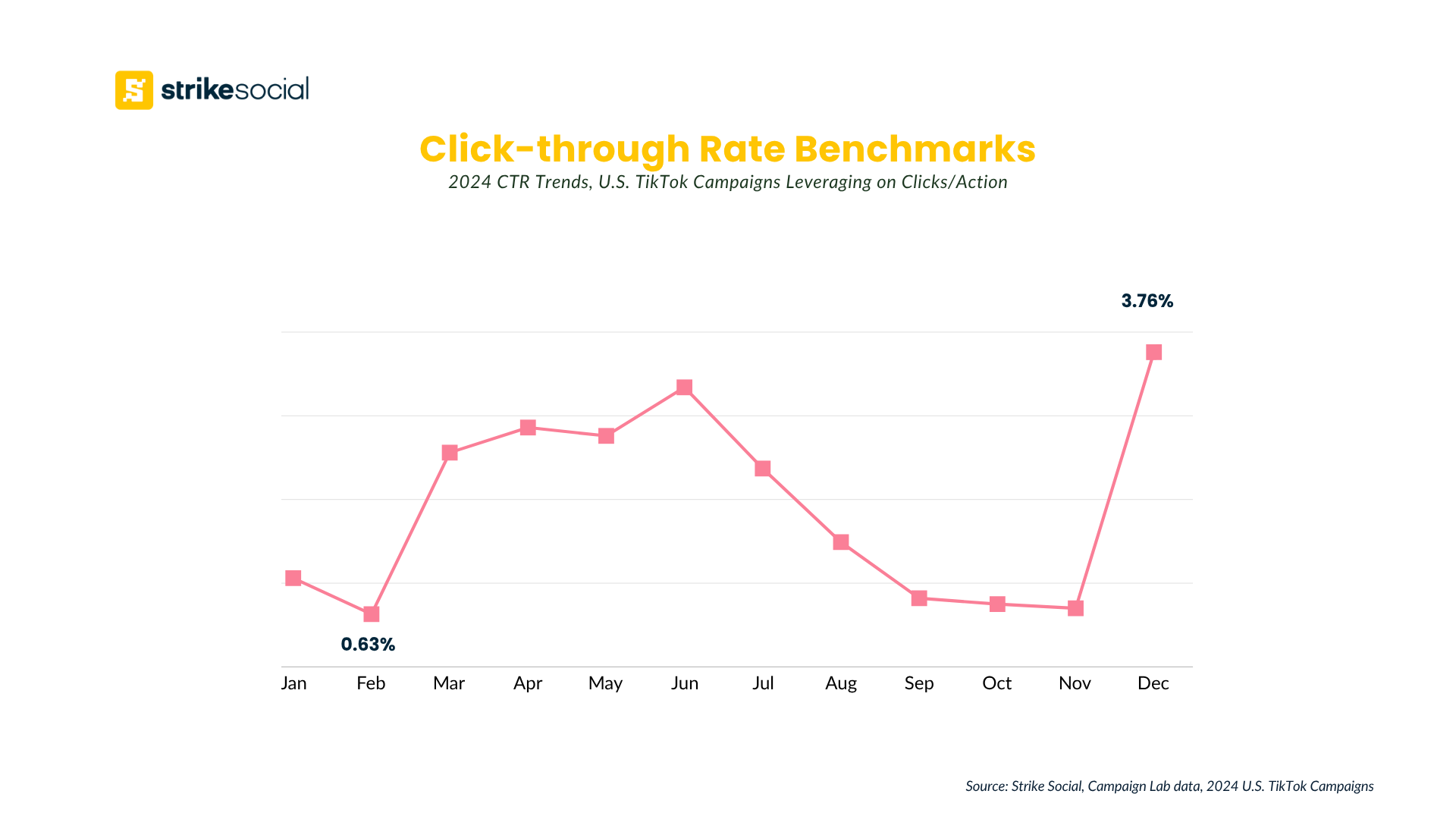
Is it better to have a low or high click-through rate?
A high CTR is definitely a positive, as it indicates that people are interested in your offer and are engaging with your ad by clicking. However, a lower CTR than the average we’ve discussed here doesn’t necessarily mean that your social media ad campaign isn’t performing well.
Does that mean you need to improve your CTA or reoptimize your YouTube targeting? Yes, this is definitely a point for improvement if your main focus on your campaigns is getting clicks. Although, for non-engagement-focused campaigns such as Connected TV reach campaigns or views-focused campaigns like Video View Campaigns, this may not be the best metric to measure your success against.
Want to know which advertising metric you should focus on based on your ad campaign type? Check out our ad metric guides here:
Time to gather those clicks!
Now that you’ve learned what goes into click-through rate and how to calculate it, you’re ready to apply these findings to improve your ad campaigns. It’s time to peel back the top layer of metrics and make improvements with a deeper understanding of what all those numbers mean.



